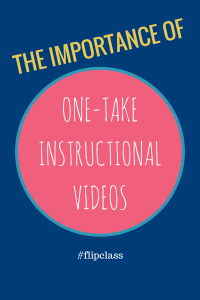 As the 3rd Quarter of my first year as a “flipper” comes to a close, I think it’s again time to reflect on my experiences. (For the importance of reflection in teaching, click here)
As the 3rd Quarter of my first year as a “flipper” comes to a close, I think it’s again time to reflect on my experiences. (For the importance of reflection in teaching, click here)
In addition to transitioning my classroom from the so-called “traditional” flipped environment, and using instead the “in-class” flip, I’ve also changed the way I create my videos.
Earlier in the year, I spent way too much time creating my flipped videos…specifically editing my videos.
I wanted to make sure my voice sounded ok, my facial expressions weren’t too distracting, etc.
My biggest and most time consuming hiccup occurred when I inevitably made a mistake. I’ve taught this content for years, and feel quite comfortable with it. However, there is something scary about recording yourself, knowing that your video will be shown to your students, their parents, the community, and THE WORLD!!
I spent an incredible amount of my valuable time rerecording my videos over and over making sure they were 100% perfect.
Looking back, I realize just how much of my valuable time I spent meticulously critiquing my instructional videos.
When we stand in front of our class delivering material in a “traditional” fashion, do we ever get tripped up or tongue-tied?
Um, yes.
Do we sometimes misspeak?
Yup. Sure do.
When these “mistakes” are made in a traditional classroom environment, do we tell our students to rip up their notes so we can go over the same content during the next class period?
I doubt it.
Enter one take video creation.
If you make small mistakes, trip over your words, or make a less than flattering face…it’s ok. Even if, in your coffee deprived bleary-eyed state, you tell your students that the John Locke’s theory of natural rights included life, liberty, and the pursuit of happiness…I may have done that once…it’s ok.
Use your mistake as a teaching tool…embed a question about the topic you mistakenly discussed in your video management system (like my favorite, EDpuzzle!) Make sure you emphasize and reemphasize the correct information later in the video.
Leave your mistakes and imperfect moments in your videos.
Doing so will not only preserve more of your precious time, but will also give your video a human element. This can allow your students feel as though they are having a conversation with you, and may help them connect more with the content. After all, their human TEACHER and NOT A COMPUTER is delivering their content.
Thanks for reading 🙂
I am a class teacher. But not a traditional teacher. I use educational technology in the classroom. Nice to meet you, I follow you. Best wishes.
It’s nice to “meet” you, too! Thanks for stopping by 🙂